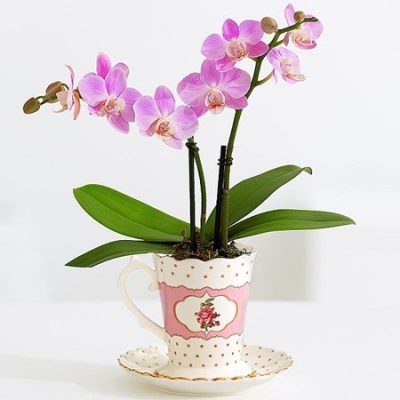
orchids
The beauty, complexity and incredible diversity of orchid flowers are unrivalled in the plant world. These exotic beauties comprise the largest family of flowering plants on earth, with over 30,000 different species, and at least 200,000 hybrids. Orchids can be found in the equatorial tropics, the arctic tundra, and everywhere in between. The reason for this diversity lies in the orchid’s amazing ability to adapt to its given environment. With so many different orchid varieties that thrive in so many different growing conditions, it is relatively easy to find an orchid that is well suited to the conditions that you can provide — whether it is a kitchen window or a full-size greenhouse.
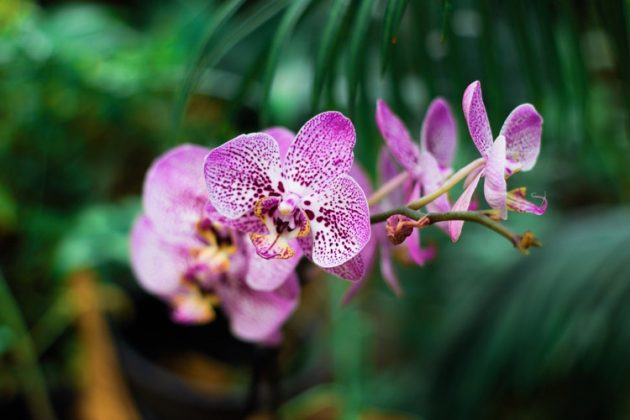 Most cultivated orchids are native to the tropics. In their natural habitat, they attach themselves to the bark of trees, or the surface of other plants. Their thick, white roots are specially adapted to absorb moisture and dissolved nutrients. Because these tropical orchids usually grow high in the trees, rather than on the forest floor, they are accustomed to good air circulation and plenty of light. They prefer a 12-hour day, all year-round, and require a high intensity of light — about the same as midsummer conditions in temperate regions.
Most cultivated orchids are native to the tropics. In their natural habitat, they attach themselves to the bark of trees, or the surface of other plants. Their thick, white roots are specially adapted to absorb moisture and dissolved nutrients. Because these tropical orchids usually grow high in the trees, rather than on the forest floor, they are accustomed to good air circulation and plenty of light. They prefer a 12-hour day, all year-round, and require a high intensity of light — about the same as midsummer conditions in temperate regions.
Are orchids difficult to grow? Many of them are. In fact, some are almost impossible to keep alive, much less bring into bloom—even for professional growers. But there are dozens of varieties of orchids, and hundreds of hybrids, that are perfectly happy growing on a sunny windowsill or under lights.
For your best crack at success, start by choosing one of the less fussy varieties that is adapted to the type of growing conditions you can provide. Buy the most mature plant you can afford (young plants are much more difficult to please), and, if possible, buy it in bloom, so you’ll know what you’re striving for.
How Orchids Grow
Orchids are usually grouped into two broad categories that characterize their growth habits. Monopodial orchids have a single, upright stem, with leaves arranged opposite each other along the stem. The flower stem appears from the base of the uppermost leaves. Orchids with this growth habit include the phalaenopsis and vandas.
The more common growth habit is sympodial. These orchids grow horizontally, sending out new shoots from the old rhizome. Leaves and flower scapes form at the top of the new shoots. Many sympodial orchids form pseudobulbs, which are swollen shoots that store water and nutrients to help the plant survive periods of prolonged drought. Sympodial orchids include cattleya, cymbidium, oncidium and dendrobium.
Orchids can also be classified by their native habitat, which gives an indication of the temperature, moisture and light levels they prefer. Orchids native to the humid tropics, such as phalaenopsis and paphiopedilum, prefer daytime temperatures of 73° to 85°F, with 80 to 90 percent humidity. They are happiest in an east or southeast window where the light is not too intense.
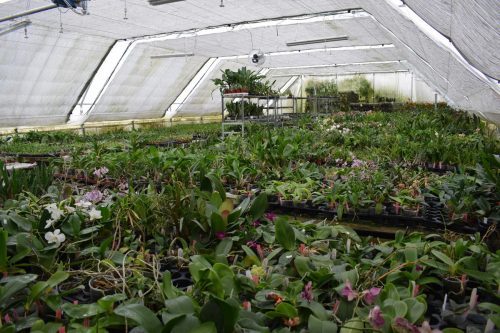
Grow Orchids
Warm-climate orchids, including cymbidiums and dendrobiums, are accustomed to an average temperature of 55° to 70°F, a steady supply of moisture, and good air circulation. They are generally happy in a south-facing window, though they may need a little shading during high summer.
Cattleyas and some oncidiums grow where days are dry and relatively cool. They are able to tolerate a long dry season with temperatures of 80° or 90°F, followed by a distinct rainy season. Their need for light is high, so they should be placed in a sunny, south-facing window.
High-altitude orchids, such as masdevallia and epidendrum, grow in the cloud forests where average temperatures are 60° to 70°F, and humidity is very high. These orchids prefer filtered light that is not too intense.
Caring for Orchids
With 30,000 different species of orchids, it is impossible to give general care and cultivation instructions. However, how an orchid looks can provide clues to its preferences for light, water, and growing medium.
If the plant has few leaves, or leathery leaves (like most cattleyas and oncidiums), it’s likely the plant needs a high-light environment. If the leaves are soft and limp (like some phalaenopsis and most paphiopedilum), the plants are probably very light-sensitive, and should not be placed in a sunny south-facing window.
If the orchid has fat pseudobulbs, it should be watered sparingly, and should be grown on coarse chunks of bark or lava rock. If the orchid has no pseudobulbs, it may require more frequent watering, or should be grown in a more moisture-retentive growing medium, such as sphagnum moss.
Growing media
Terrestrial orchids, such as paphiopedilums and some cymbidiums, grow in soil. But most tropical orchids are epiphytes, which means that they grow in the air, rather than in soil. Their fleshy roots are covered with a layer of white cells called velamen, which acts as a sponge to absorb water. The coating also protects the roots from heat and moisture loss.
An orchid growing medium must provide good air circulation and permit water to drain very quickly. It must also give the roots something secure to cling to. Depending on the type of orchid, they can be happy growing in peat moss, fir bark, dried fern roots, sphagnum moss, rock wool, perlite, cork nuggets, stones, coconut fiber, lava rock or a blend that combines several of these materials. Some epiphytic orchids can also be wired onto slabs of tree fern or cork. As a general rule, fir bark nuggets are the most popular growing medium.
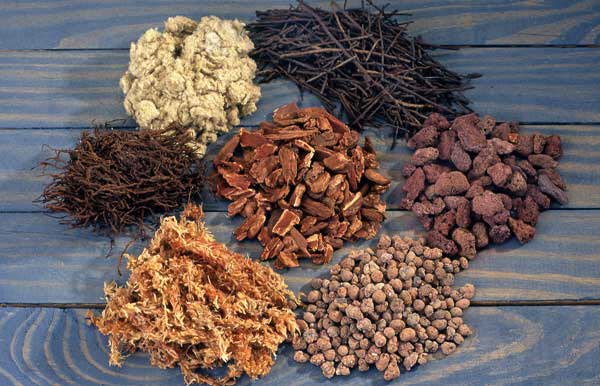
Light
As a general rule, orchids are light-hungry plants. For best results, they should get 12 to 14 hours of light each day, year-round. In a tropical environment, the duration and intensity of natural light does not vary as it does in temperate climates. For this reason, you may need to move your orchids around, and supplement with artificial light to keep them happy during the winter months.
South- and east-facing windows are usually the best spot for orchids. West windows can be too hot, and northern ones are usually too dark. If you don’t have a good window location for your orchids, they will be perfectly happy growing under artificial lights. Orchids should be positioned no more than 6 to 8 inches away from a set of 4-foot fluorescent bulbs. Opinions vary as to the benefits of cool white, warm white, and grow light bulbs. The new full-spectrum bulbs are probably the best all-around choice. Some orchids with very high light requirements, such as vandas and cymbidiums, may need high-intensity discharge lighting in order to flower. For more information, read Growing Under Lights.
Fertilizer
Orchid-growing mediums provide very few nutrients, so orchids must be fertilized to sustain healthy growth. Use a liquid fertilizer, and dilute it more than you would for other plants. Fertilizer should only be applied when plants are in active growth. This means that most orchids should not be fertilized in midwinter, or right after they have been re-potted. Many growers use a 30-10-10 fertilizer, though others prefer 10-10-10 or 10-10-30. Misting your orchids with fish emulsion or seaweed extracts will provide micronutrients.
Watering
Most orchids can tolerate drought far better than they can tolerate excess moisture. Nothing kills an orchid faster than letting it sit in a water-logged pot. Without adequate air circulation, the plant will suffocate and die.
As a very general rule, orchids should be watered once a week. The growing medium should be allowed to dry out between waterings, and excess water should not come in contact with the roots or the growing medium. After being re-potted, most orchids will not resume active growth for several months. Water very sparingly during this readjustment period.
Humidity
Most tropical orchids prefer humidity levels of 60 to 80 percent. With the winter-time humidity level in most homes hovering closer to 30 percent, orchid growers often use a humidifier, or set their orchids in special humidity trays or gravel-filled trays. Some orchids also benefit from being misted.
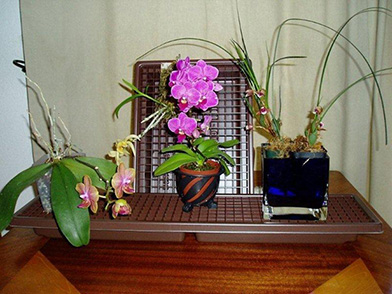
orchid-humidity
How and When repot an Orchids?
Orchid roots are overflowing the pot
The plant itself is going over the edge of the pot
Potting material is getting soggy and drains poorly
The ideal time to repot most orchids is when the plant starts new growth — usually right after it finishes flowering.
Prepare the potting mix
Choose a potting mix that suits your particular type of orchid. Whether you mix it yourself or buy it ready-made — it must be wetted before you use it. Otherwise, it’ll never hold moisture properly and will always dry out.
how you prepare the orchid mix for potting:
Pour the amount of potting material you intend to use into a bucket that has about twice the volume of the mix.
Fill the bucket with hot water.
Hot water penetrates the material better than cold water.
Let the mixture soak overnight.
The next day, pour out the mix into a colander or strainer.
Rinse the mix thoroughly to wash out the dust that was in the mix.
Now the mix is ready to use.
Time to repot
When you’re ready to repot the orchid, spread out some newspaper over a work surface. Gather up a knife, scissors, new orchid pots (or old ones that are thoroughly cleaned), wooden stakes, and soft ties.
Now, follow these steps:
Remove the orchid from the pot.
You may need to use a knife to circle the inside of the pot and loosen the roots.
Remove the old, loose, rotted potting material and any soft, damaged, or dead roots.
If the roots are healthy, firm, and filling the pot, put the orchid in a pot just one size larger than the one you removed it from, placing the older growth toward the back so the new lead or growth has plenty of room.
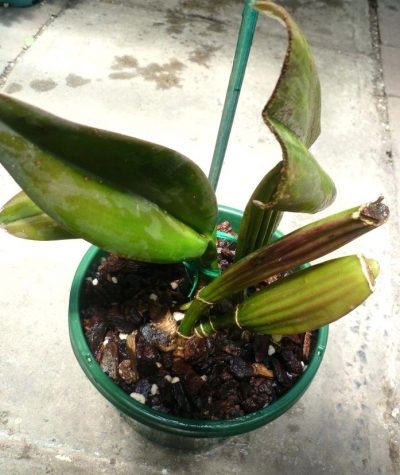
when-to-repot-orchids-orchid-after-repotting-orchids-for-dummies
If the roots are rotted and in poor condition, repot the plant in a container of the same or one size smaller than it was removed from.
If you place a poorly rooted plant in a container that’s too large, the growing material will stay too damp, which will result in root rot.
Some orchid growers like to add a coarse material like broken clay pots or Styrofoam in the bottom of the pots to improve drainage. You don’t have to do this if you’re using shallow, azalea-type pots.
Place the plant in the pot so it’s at the same depth as it was originally.
The new shoot should be level with the pot rim.
Press the fresh potting material into the pot and around the orchid roots with your thumbs and forefingers.
The orchid should be secure in the pot so it doesn’t wiggle — otherwise, the new roots won’t form properly.
Place a wooden or bamboo stake in the center of the pot, and tie up the new and old leads with soft string or twist ties.
When orchids are in bloom, the staking techniques will vary, depending on the type of orchid.